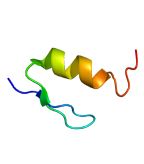New Monoclonal Antibody Targets Intracellular Oncogenic Proteins in Leukemias
Researchers have discovered a fully human “T-cell receptor–like” monoclonal antibody specific for the Wilms tumor 1 oncoprotein-an intracellular oncogenic transcription factor that is overexpressed in a wide range of leukemias, as well as solid cancers.
Researchers have discovered a fully human “T-cell receptor–like” monoclonal antibody specific for the Wilms tumor 1 (WT1) oncoprotein-an intracellular oncogenic transcription factor that is overexpressed in a wide range of leukemias, as well as solid cancers. Currently available anticancer monoclonal antibodies recognize extracellular or cell surface proteins, which make up only a small fraction of the cellular proteins and are not tumor-specific. Thus, targeting intracellular oncogenic proteins is a key goal of cancer research. A panel convened by the National Institutes of Health recently ranked WT1 as the number one target for immunotherapy.

Structure of the WT1 protein; source: Emw, Wikimedia Commons
Investigators from Memorial Sloan-Kettering Cancer Center in New York and Eureka Therapeutics in Emeryville, California have collaborated to create the new monoclonal antibody, known as ESK1. The first studies of the antibody are showing promise in preclinical research as a treatment for leukemia, as reported earlier this month in Science Translational Medicine, a weekly publication of the American Association for the Advancement of Science.
While WT1 is overexpressed in leukemias and other cancers, including myeloma, and breast, ovarian, and colorectal cancers, it is found in few healthy cells, which makes side effects less likely to occur from drugs that target it. “This is a new approach for attacking WT1, an important cancer target, with an antibody therapy,” said lead author David A. Scheinberg, MD, PhD, chair of the Sloan-Kettering Institute's molecular pharmacology and chemistry program and an inventor of the antibody. “This is something that was previously not possible. There has not been a way to make small-molecule drugs that can inhibit WT1 function. Our research shows that you can use a monoclonal antibody to recognize a cancer-associated protein inside a cell, and it will destroy the cell.”
In the current study, “ESK1 bound to several leukemia and solid tumor cell lines and primary leukemia cells,” wrote the authors. “Low doses of naked ESK1 antibody cleared established, disseminated, human acute lymphocytic leukemia and Philadelphia chromosome–positive leukemia in nonobese diabetic/severe combined immunodeficient γc−/− (NSG) mouse models. At therapeutic doses, no toxicity was seen in HLA-A0201 transgenic mice.”
“We were surprised that the antibody worked so well on its own,” said Scheinberg. “We had originally expected that we might need to use the antibody as a carrier to deliver a drug or a radioactive therapy to kill the cancer cells, but this was not necessary.”
The researchers reported that ESK1 showed “fast and potent therapeutic activity alone both in a disseminated human BCR/ABL+ acute leukemia xenograft model and a disseminated pre-B ALL model.” Addition of CD3−/CD34− human effector cells further improved long-term outcomes and prolonged survival. “Leukemia returned more quickly in the monoclonal antibody alone group compared with ESK1 combined with effectors, showing that ESK1-mediated human [antibody-dependent cell-mediated cytotoxicity] likely plays an important role in eliminating tumor cells long term.” They noted, however, that “predicting the depth and duration of effects that will be seen in humans is difficult.” Moreover, additional studies must be done in the laboratory before ESK1 will be ready to be tested in patients. But the monoclonal antibody was engineered to be fully human, which should speed the time it takes to move the drug into the clinic. Researchers expect that the first clinical trials, for leukemia, could begin in about a year.
“More than one million patients worldwide may have a WT1+ tumor or leukemia, and up to one-third of these may have an HLA-A02 haplotype,” the authors concluded. “Hence, an effective antibody therapeutic agent could have large clinical impact.”
The antibody was developed under a collaborative effort between Memorial Sloan-Kettering and Eureka, which have jointly filed for patent protection. “ESK1 represents a paradigm change for the field of human monoclonal antibody therapeutics,” said Cheng Liu, PhD, president and chief executive officer of Eureka Therapeutics. “This research suggests that human antibody therapy is no longer limited to targeting proteins present outside cancer cells, but can now target proteins within the cancer cell itself.”
The study was supported by grants from the Leukemia & Lymphoma Society, the National Cancer Institute, the Sloan-Kettering Institute's Experimental Therapeutics Center and Technology Development Fund, the Commonwealth Foundation for Cancer Research, the Tudor and Glades Foundations, the Merker Fund, the Lymphoma Foundation, and the Mesothelioma Applied Research Foundation.
Targeted Therapy First Strategy Reduces Need for Chemotherapy in Newly Diagnosed LBCL
December 7th 2025Lenalidomide, tafasitamab, rituximab, and acalabrutinib alone may allow 57% of patients with newly diagnosed LBCL to receive less than the standard number of chemotherapy cycles without compromising curative potential.